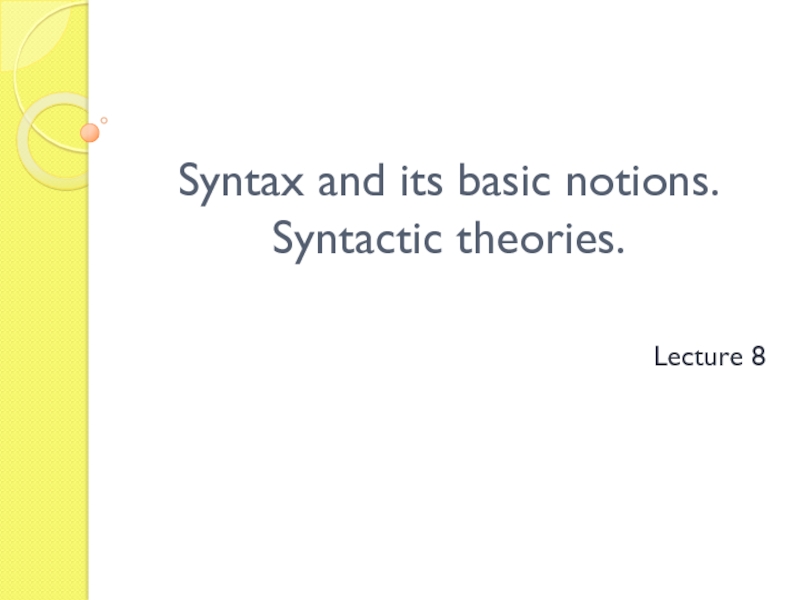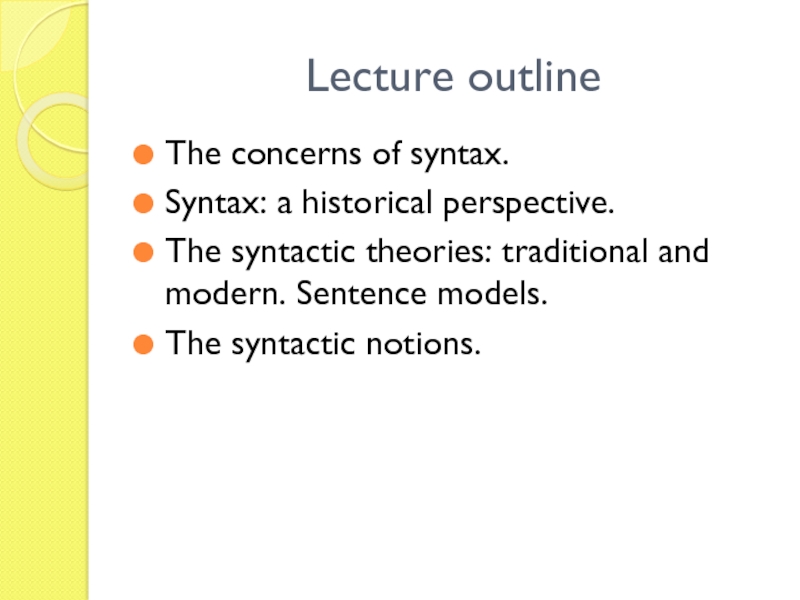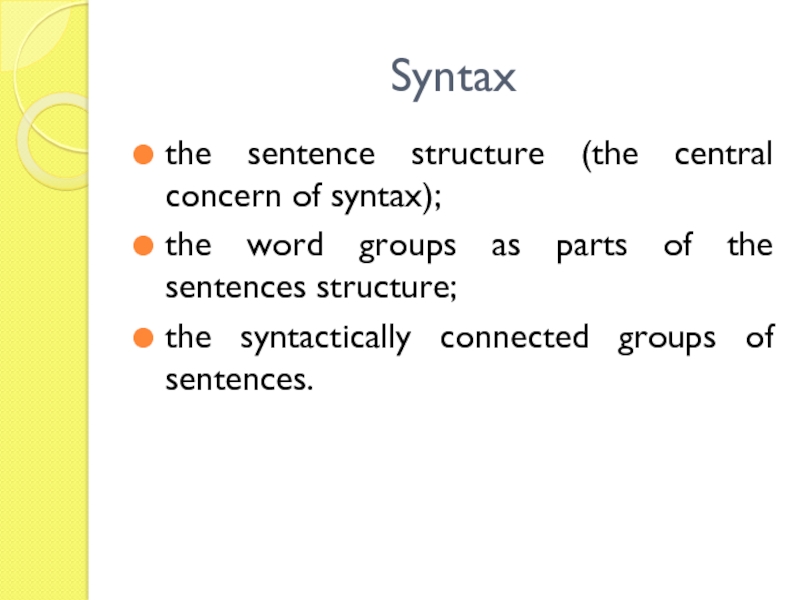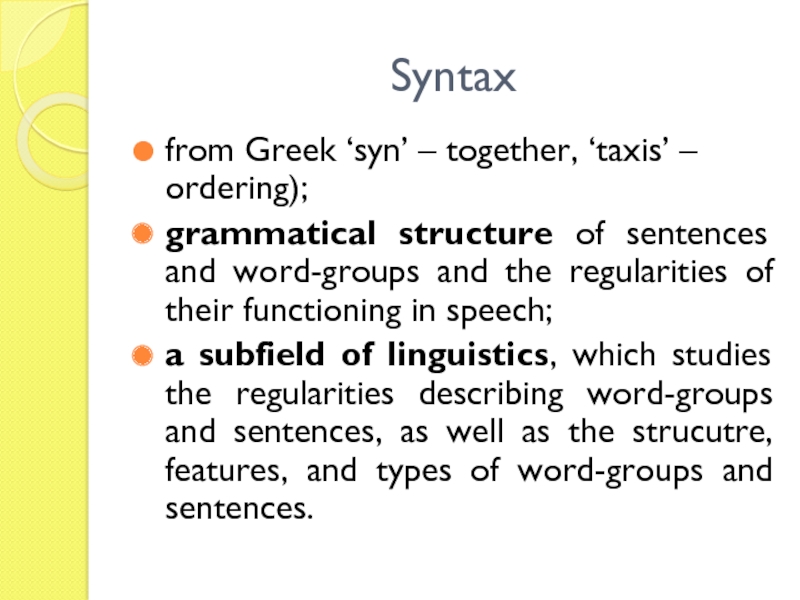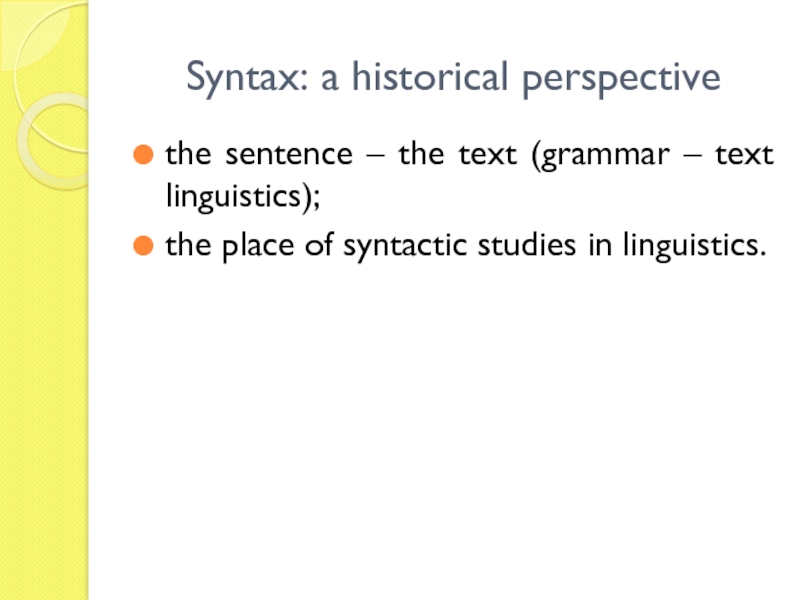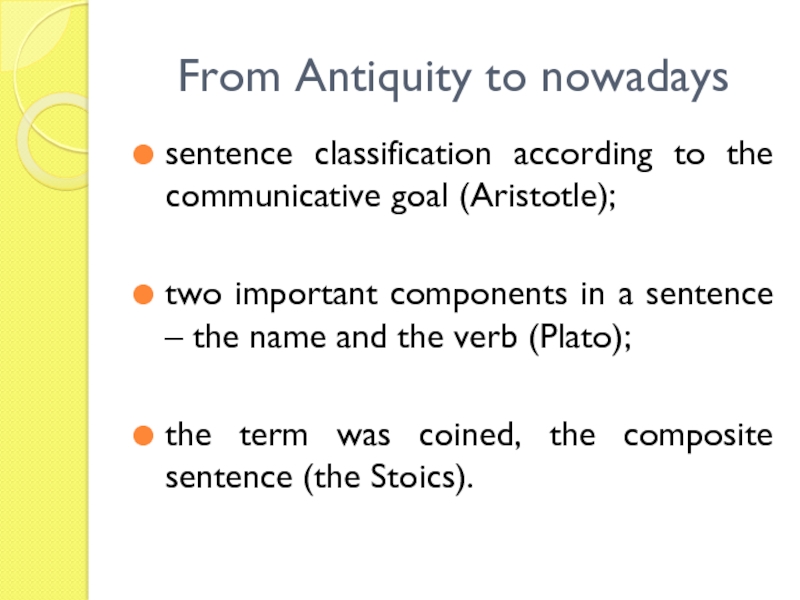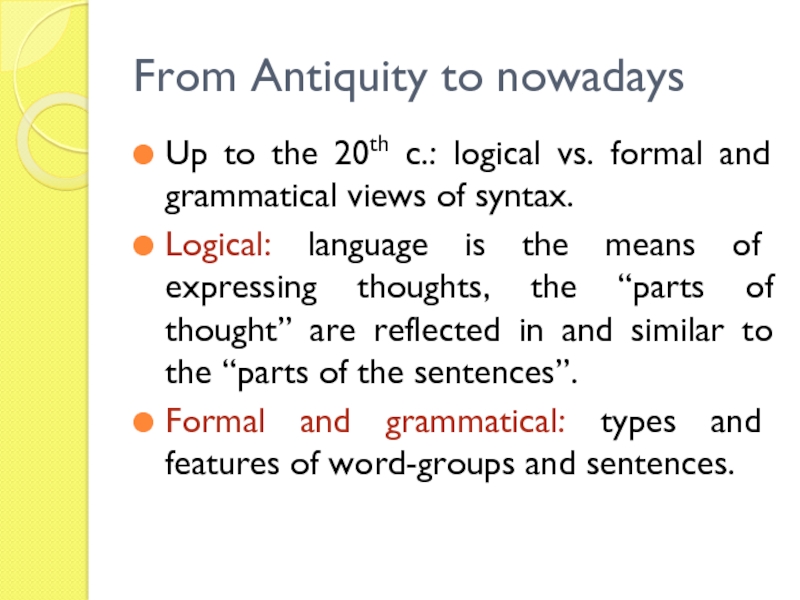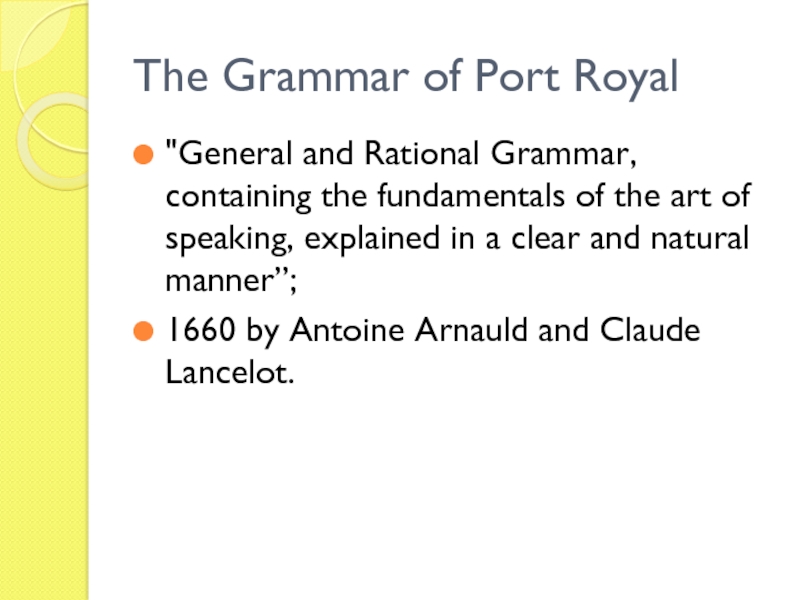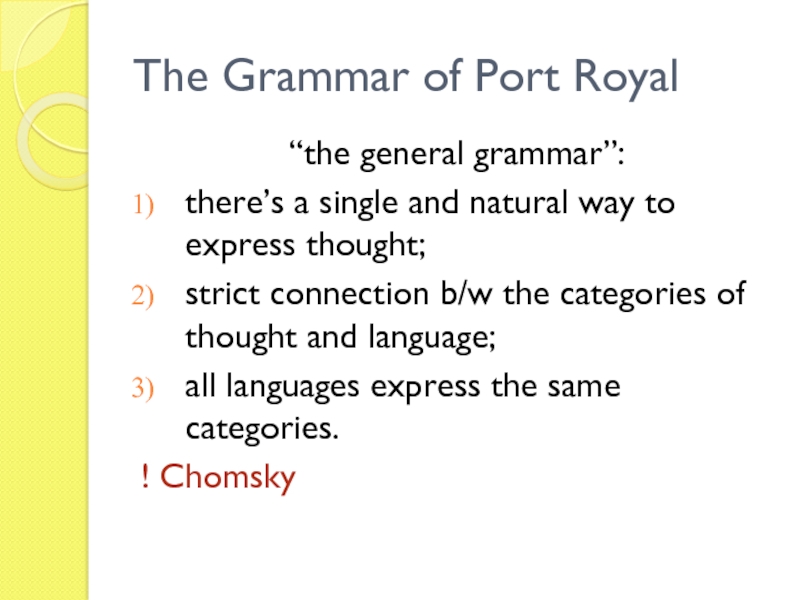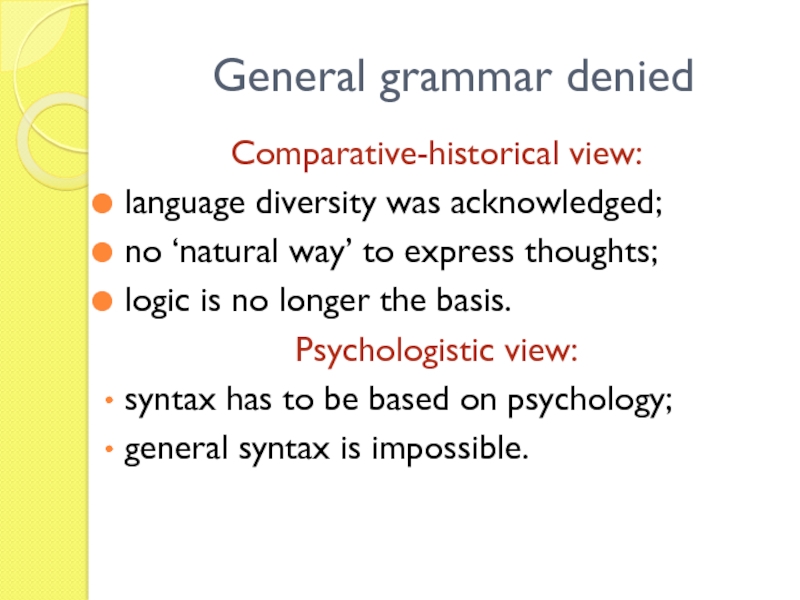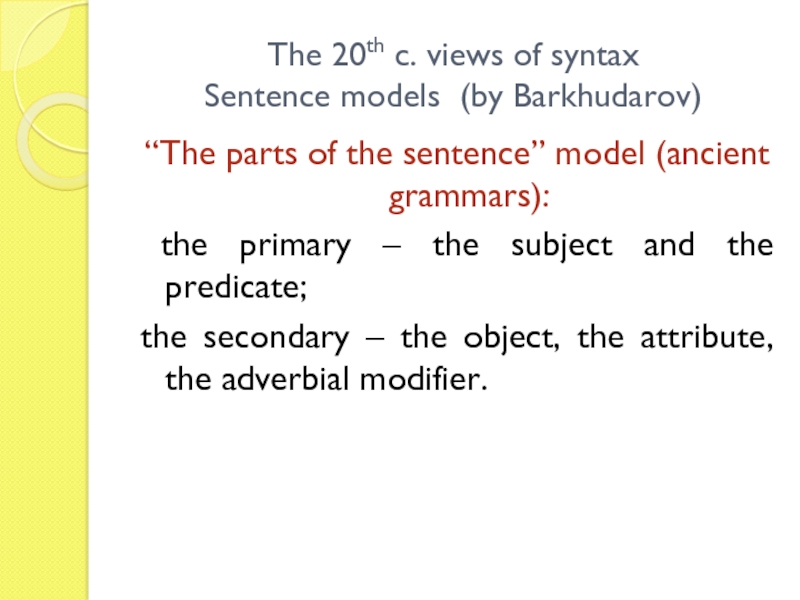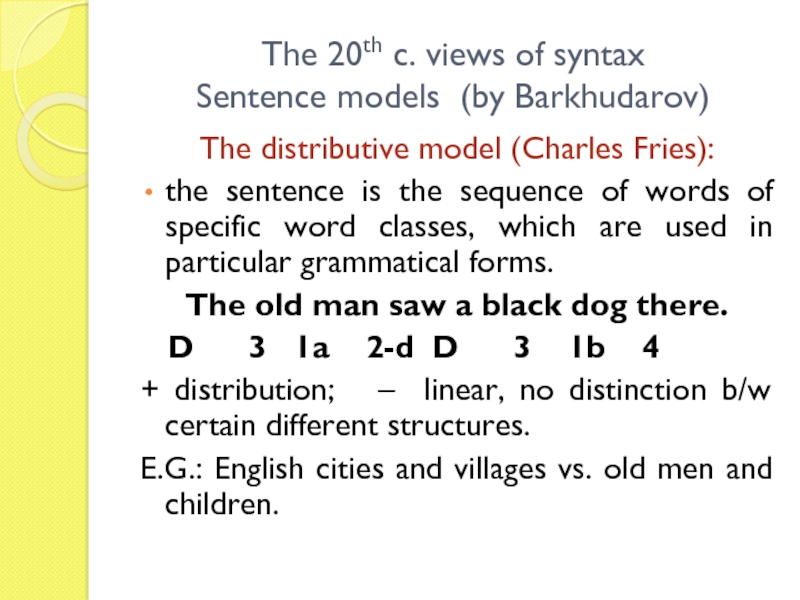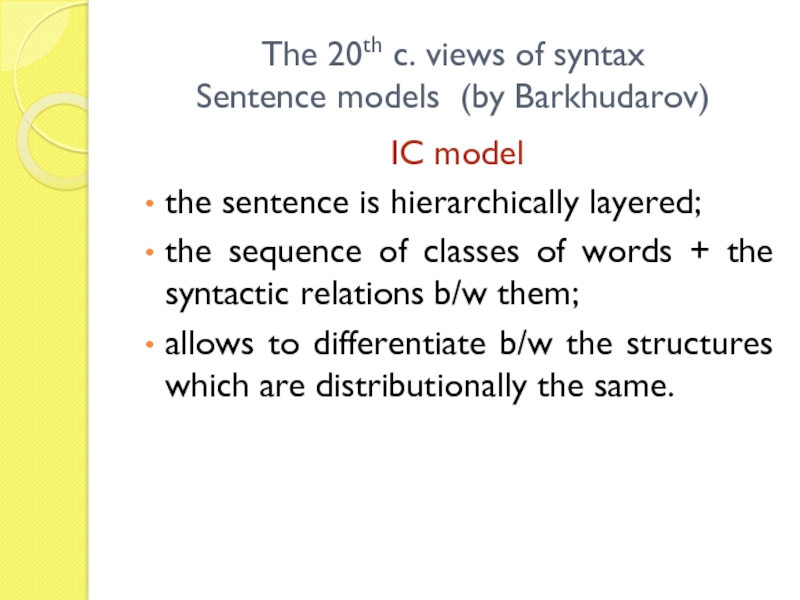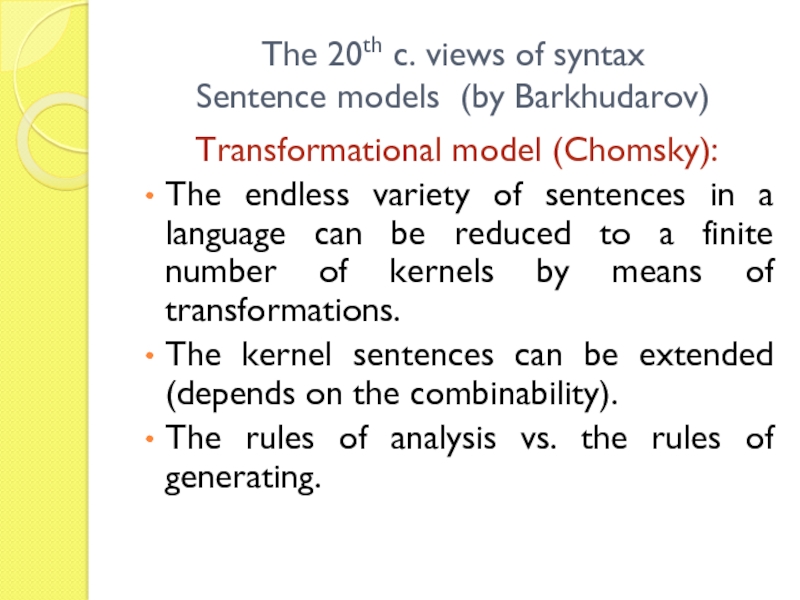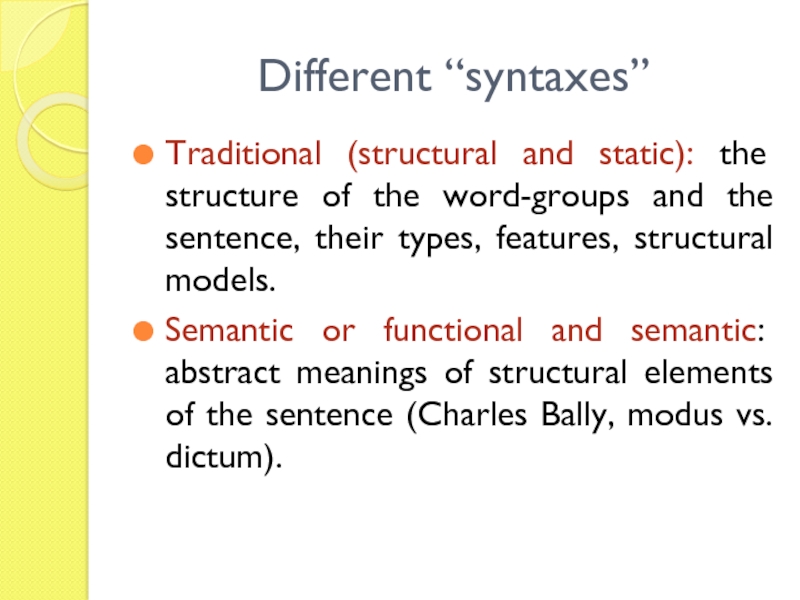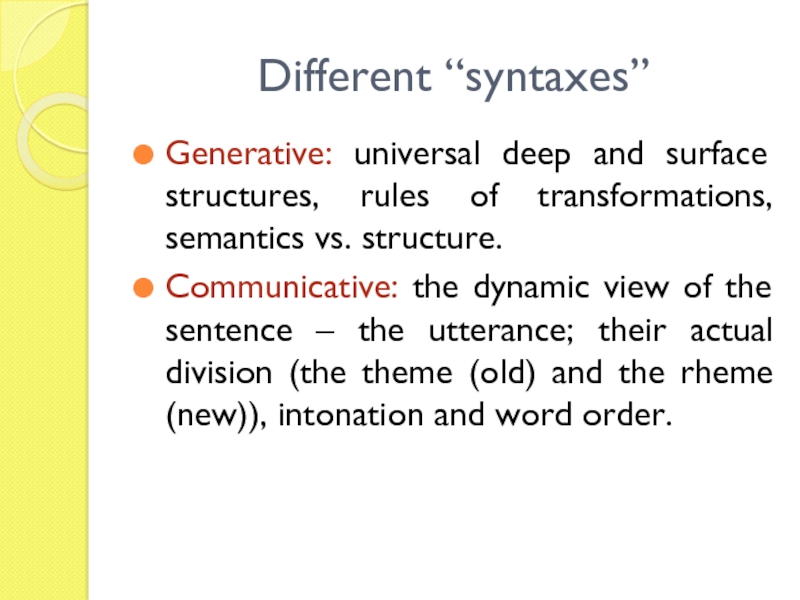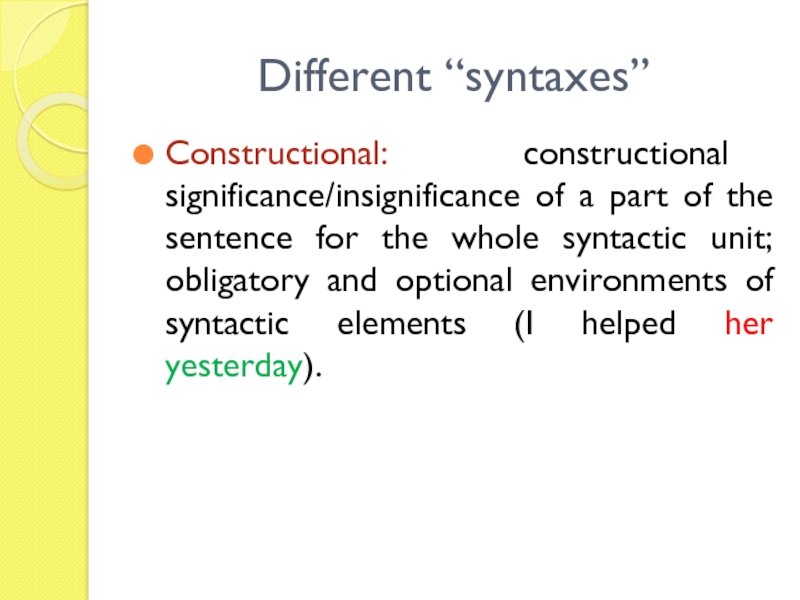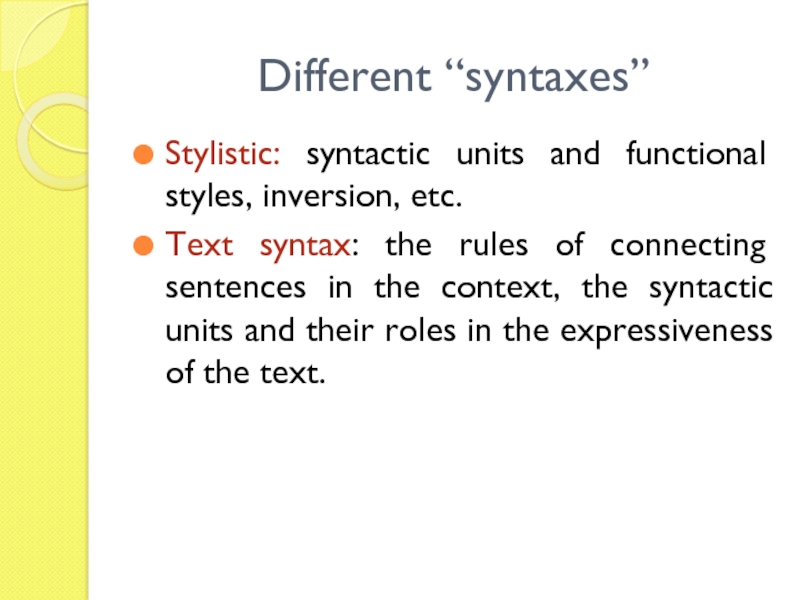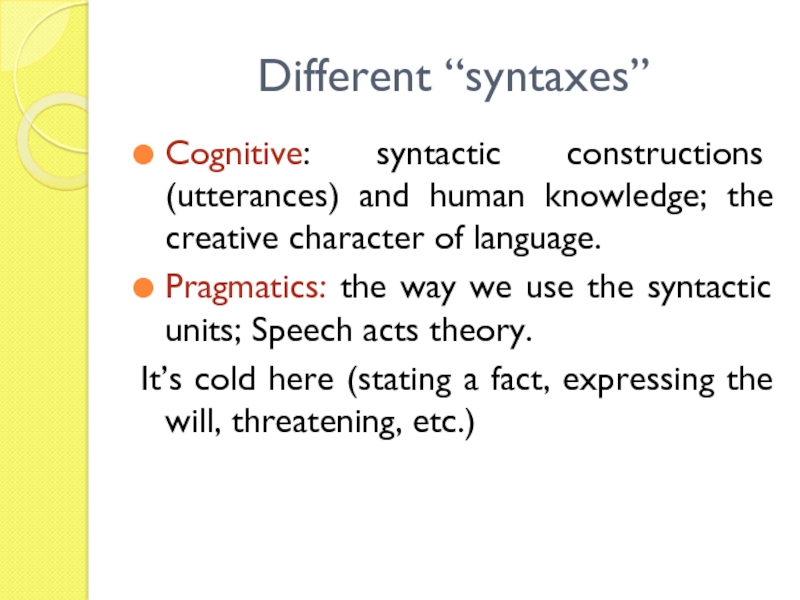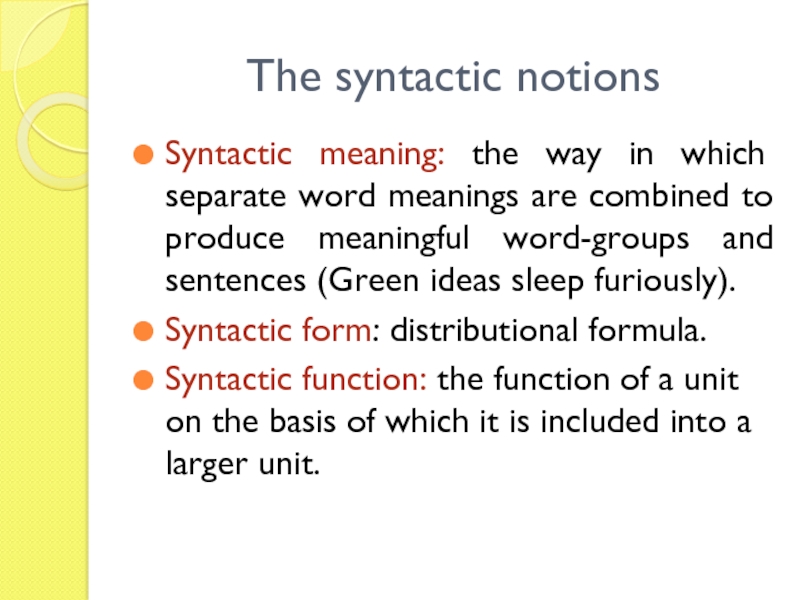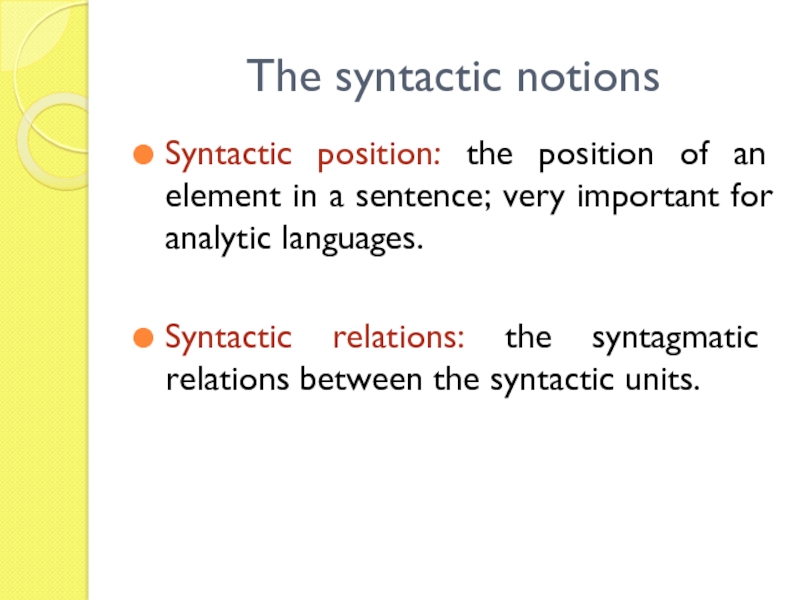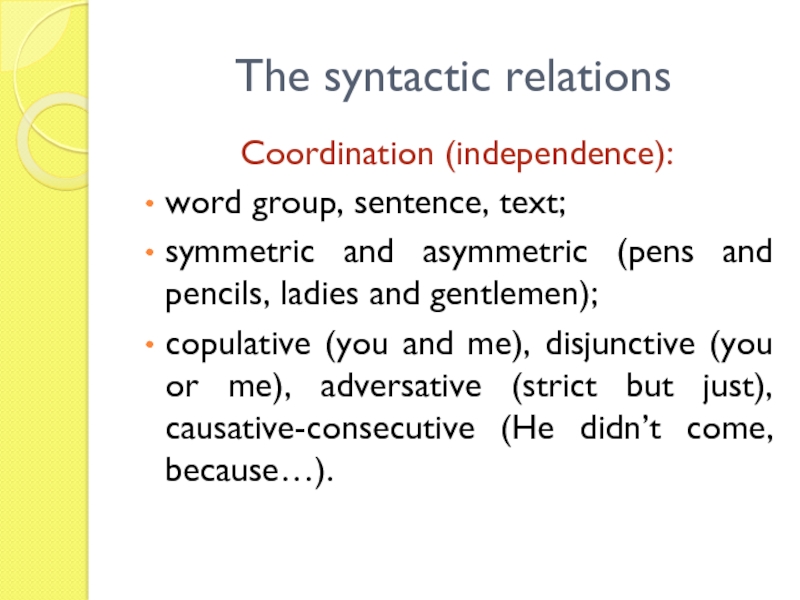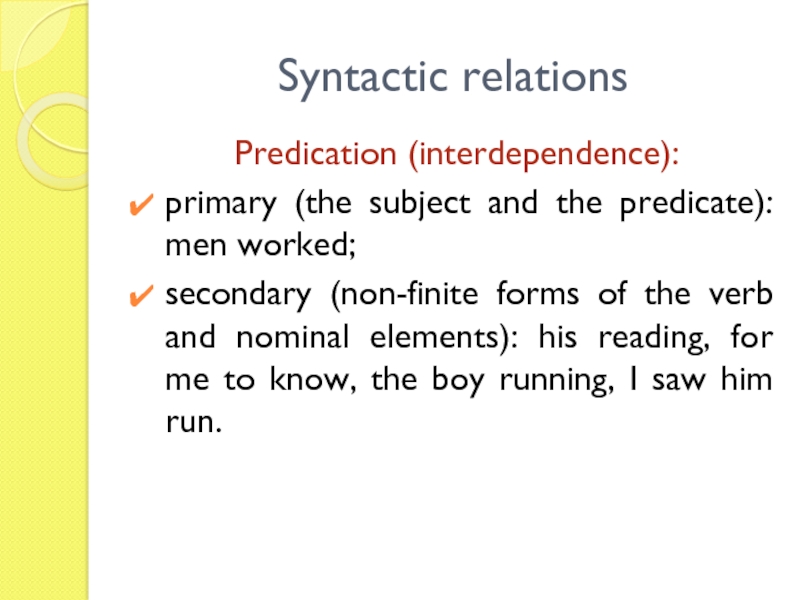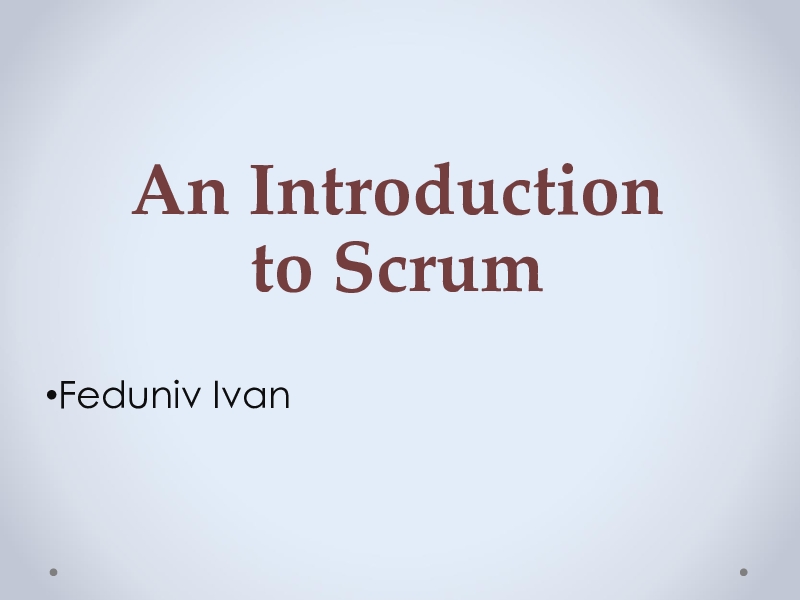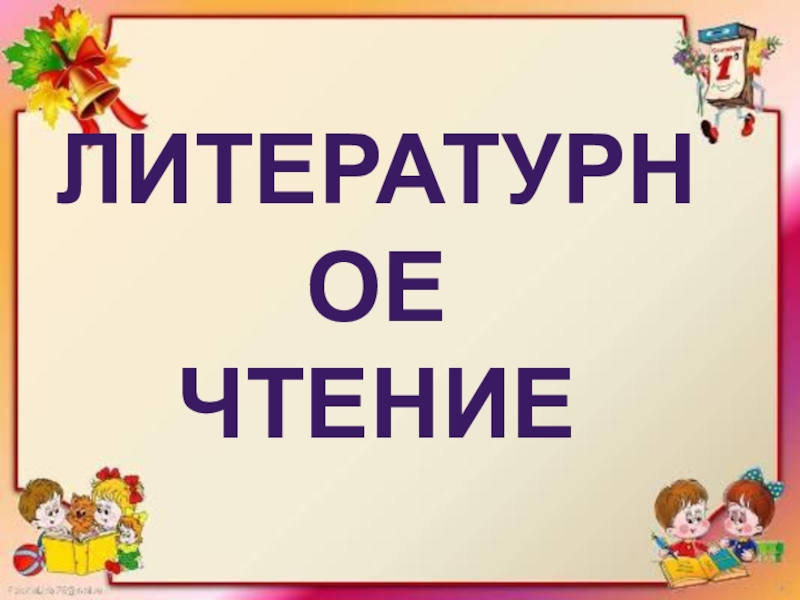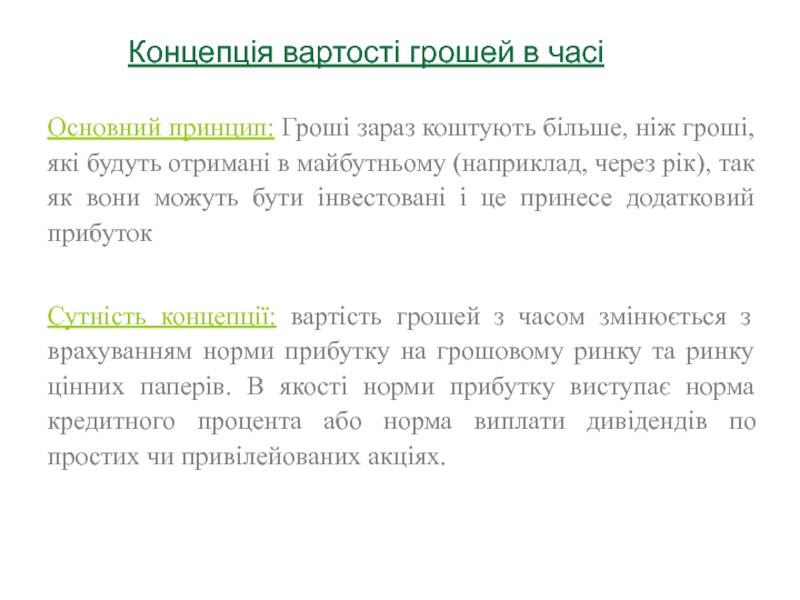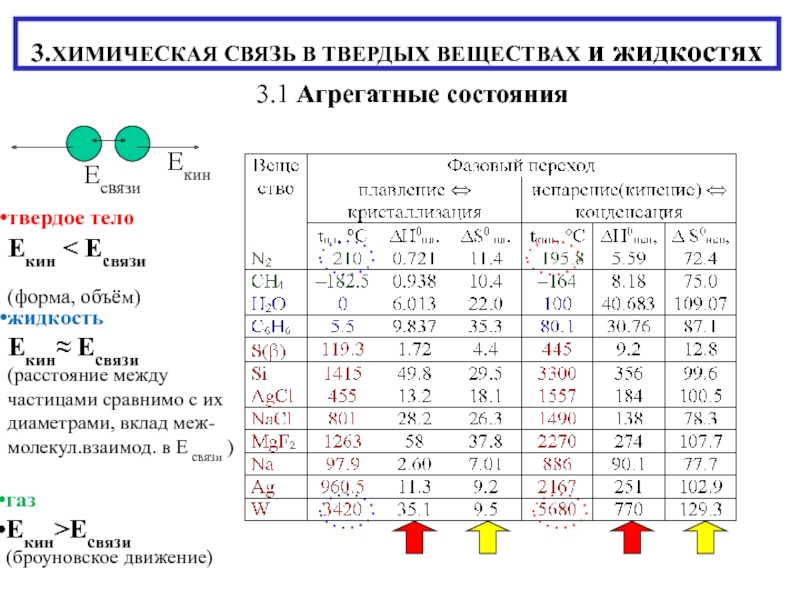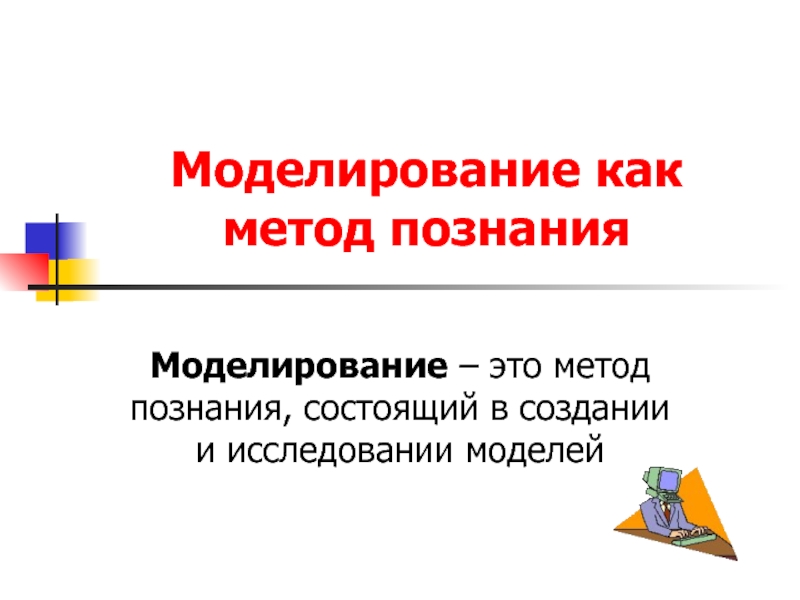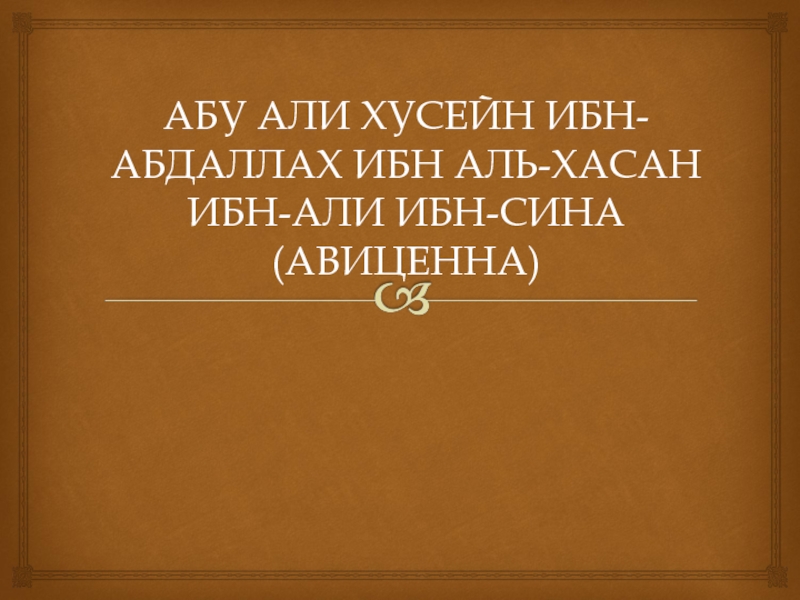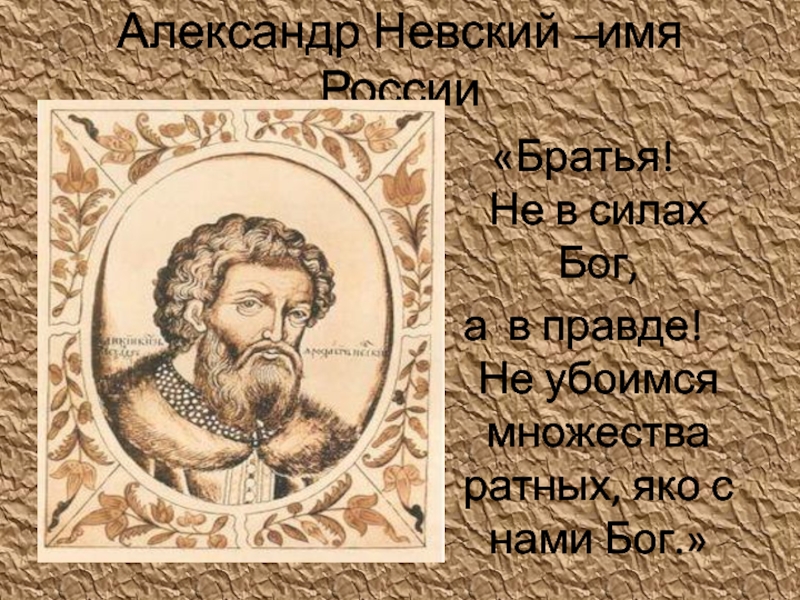Разделы презентаций
- Разное
- Английский язык
- Астрономия
- Алгебра
- Биология
- География
- Геометрия
- Детские презентации
- Информатика
- История
- Литература
- Математика
- Медицина
- Менеджмент
- Музыка
- МХК
- Немецкий язык
- ОБЖ
- Обществознание
- Окружающий мир
- Педагогика
- Русский язык
- Технология
- Физика
- Философия
- Химия
- Шаблоны, картинки для презентаций
- Экология
- Экономика
- Юриспруденция
Syntax and its basic notions. Syntactic theories
Содержание
- 1. Syntax and its basic notions. Syntactic theories
- 2. Lecture outlineThe concerns of syntax.Syntax: a historical
- 3. Syntaxdeals with the way words are combined;
- 4. Syntaxthe sentence structure (the central concern of
- 5. Syntaxthe means of grammatical connection of words,
- 6. Syntaxfrom Greek ‘syn’ – together, ‘taxis’ –
- 7. SyntaxThe syntax of word-groups: the rules governing
- 8. Syntax: a historical perspectivethe sentence – the
- 9. From Antiquity to nowadayssentence classification according to
- 10. From Antiquity to nowadaysUp to the 20th
- 11. The Grammar of Port Royal"General and Rational
- 12. The Grammar of Port Royal“the general grammar”:there’s
- 13. General grammar deniedComparative-historical view:language diversity was acknowledged;no
- 14. The 20th c. views of syntax Sentence
- 15. The 20th c. views of syntax Sentence
- 16. The 20th c. views of syntax Sentence
- 17. IC analysis
- 18. IC analysis
- 19. The 20th c. views of syntax Sentence
- 20. The kernel sentences (English)N V
- 21. Different “syntaxes”Traditional (structural and static): the structure
- 22. Different “syntaxes”Generative: universal deep and surface structures,
- 23. Different “syntaxes”Constructional: constructional significance/insignificance of a part
- 24. Different “syntaxes”Stylistic: syntactic units and functional styles,
- 25. Different “syntaxes”Cognitive: syntactic constructions (utterances) and human
- 26. The syntactic notionsSyntactic unit: a combination that
- 27. The syntactic notionsSyntactic meaning: the way in
- 28. The syntactic notionsSyntactic position: the position of
- 29. The syntactic relationsCoordination (independence): word group, sentence,
- 30. The syntactic relationsSubordination (dependence, difference linguistic rank):word-group
- 31. Syntactic relationsPredication (interdependence):primary (the subject and the
- 32. Скачать презентанцию
Lecture outlineThe concerns of syntax.Syntax: a historical perspective.The syntactic theories: traditional and modern. Sentence models.The syntactic notions.
Слайды и текст этой презентации
Слайд 2Lecture outline
The concerns of syntax.
Syntax: a historical perspective.
The syntactic theories:
traditional and modern. Sentence models.
Слайд 3Syntax
deals with the way words are combined;
the external functions
of words and their relationship to other words within the
linearly ordered units – word-groups, sentences, texts;the peculiarities of syntactic units, their behavior in different contexts.
Слайд 4Syntax
the sentence structure (the central concern of syntax);
the word groups
as parts of the sentences structure;
the syntactically connected groups of
sentences. Слайд 5Syntax
the means of grammatical connection of words, the study of
the word-groups;
the formation of the sentence.
Слайд 6Syntax
from Greek ‘syn’ – together, ‘taxis’ – ordering);
grammatical structure of
sentences and word-groups and the regularities of their functioning in
speech;a subfield of linguistics, which studies the regularities describing word-groups and sentences, as well as the strucutre, features, and types of word-groups and sentences.
Слайд 7Syntax
The syntax of word-groups: the rules governing the combinability of
words with other words.
The syntax of sentences: types, features of
the sentence, relations of words and word combinations in the sentence.Слайд 8Syntax: a historical perspective
the sentence – the text (grammar –
text linguistics);
the place of syntactic studies in linguistics.
Слайд 9From Antiquity to nowadays
sentence classification according to the communicative goal
(Aristotle);
two important components in a sentence – the name and
the verb (Plato);the term was coined, the composite sentence (the Stoics).
Слайд 10From Antiquity to nowadays
Up to the 20th c.: logical vs.
formal and grammatical views of syntax.
Logical: language is the means
of expressing thoughts, the “parts of thought” are reflected in and similar to the “parts of the sentences”.Formal and grammatical: types and features of word-groups and sentences.
Слайд 11The Grammar of Port Royal
"General and Rational Grammar, containing the
fundamentals of the art of speaking, explained in a clear
and natural manner”;1660 by Antoine Arnauld and Claude Lancelot.
Слайд 12The Grammar of Port Royal
“the general grammar”:
there’s a single and
natural way to express thought;
strict connection b/w the categories
of thought and language; all languages express the same categories.
! Chomsky
Слайд 13General grammar denied
Comparative-historical view:
language diversity was acknowledged;
no ‘natural way’ to
express thoughts;
logic is no longer the basis.
Psychologistic view:
syntax has to
be based on psychology;general syntax is impossible.
Слайд 14The 20th c. views of syntax
Sentence models (by Barkhudarov)
“The
parts of the sentence” model (ancient grammars):
the primary –
the subject and the predicate; the secondary – the object, the attribute, the adverbial modifier.
Слайд 15The 20th c. views of syntax
Sentence models (by Barkhudarov)
The
distributive model (Charles Fries):
the sentence is the sequence of words
of specific word classes, which are used in particular grammatical forms.The old man saw a black dog there.
D 3 1a 2-d D 3 1b 4
+ distribution; – linear, no distinction b/w certain different structures.
E.G.: English cities and villages vs. old men and children.
Слайд 16The 20th c. views of syntax
Sentence models (by Barkhudarov)
IC
model
the sentence is hierarchically layered;
the sequence of classes of words
+ the syntactic relations b/w them;allows to differentiate b/w the structures which are distributionally the same.
Слайд 19The 20th c. views of syntax
Sentence models (by Barkhudarov)
Transformational
model (Chomsky):
The endless variety of sentences in a language can
be reduced to a finite number of kernels by means of transformations.The kernel sentences can be extended (depends on the combinability).
The rules of analysis vs. the rules of generating.
Слайд 20The kernel sentences (English)
N V (John
came)
N V р N (John looked at Mary)
N V N (John saw
Mary)N is N (John is a teacher)
N is p N (John is in bed)
N is D (John is out)
N is A (John is angry)
Слайд 21Different “syntaxes”
Traditional (structural and static): the structure of the word-groups
and the sentence, their types, features, structural models.
Semantic or functional
and semantic: abstract meanings of structural elements of the sentence (Charles Bally, modus vs. dictum). Слайд 22Different “syntaxes”
Generative: universal deep and surface structures, rules of transformations,
semantics vs. structure.
Communicative: the dynamic view of the sentence –
the utterance; their actual division (the theme (old) and the rheme (new)), intonation and word order. Слайд 23Different “syntaxes”
Constructional: constructional significance/insignificance of a part of the sentence
for the whole syntactic unit; obligatory and optional environments of
syntactic elements (I helped her yesterday).Слайд 24Different “syntaxes”
Stylistic: syntactic units and functional styles, inversion, etc.
Text syntax:
the rules of connecting sentences in the context, the syntactic
units and their roles in the expressiveness of the text.Слайд 25Different “syntaxes”
Cognitive: syntactic constructions (utterances) and human knowledge; the creative
character of language.
Pragmatics: the way we use the syntactic units;
Speech acts theory.It’s cold here (stating a fact, expressing the will, threatening, etc.)
Слайд 26The syntactic notions
Syntactic unit: a combination that has at least
two constituents; hierarchical; two-fold (syntactic meaning and form), communicative and
non-communicative nature.A word-group, a clause, a sentence, and a text.
Слайд 27The syntactic notions
Syntactic meaning: the way in which separate word
meanings are combined to produce meaningful word-groups and sentences (Green
ideas sleep furiously).Syntactic form: distributional formula.
Syntactic function: the function of a unit on the basis of which it is included into a larger unit.
Слайд 28The syntactic notions
Syntactic position: the position of an element in
a sentence; very important for analytic languages.
Syntactic relations: the syntagmatic
relations between the syntactic units.Слайд 29The syntactic relations
Coordination (independence):
word group, sentence, text;
symmetric and
asymmetric (pens and pencils, ladies and gentlemen);
copulative (you and
me), disjunctive (you or me), adversative (strict but just), causative-consecutive (He didn’t come, because…).Слайд 30The syntactic relations
Subordination (dependence, difference linguistic rank):
word-group and sentence;
adverbial (to
run slowly), objective (to help a friend); attributive (a new
house);the head and the adjunct.
